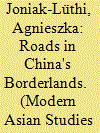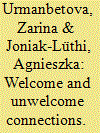|
|
|
Sort Order |
|
|
|
Items / Page
|
|
|
|
|
|
|
| Srl | Item |
| 1 |
ID:
144217


|
|
|
|
|
| Summary/Abstract |
Since the beginning of the twenty-first century, the tarmac road network in Xinjiang Uyghur Autonomous Region in northwest China has been greatly expanded. The total length of roads increased from about 30,000 kilometres in 1999 to more than 146,000 kilometres in 2008. Though roads are considered by the state to be instruments of economic development, in multi-ethnic border regions like Xinjiang, the role of an efficient road network in the construction of the Chinese state's imaginary ‘bounded space’ is arguably just as crucial. With the help of Lefebvre's (1991) and Soja's (1999) conceptualization of space, this article explores the multiple spatial figurations of which roads are a part in Xinjiang. The article starts from ‘the mappable’ dimension of the expanding road network, and moves on to discuss perceptions and representations related to this expansion, before finally discussing how individuals creatively explore its fissures and hidden pockets.
|
|
|
|
|
|
|
|
|
|
|
|
|
|
|
|
| 2 |
ID:
185923


|
|
|
|
|
| Summary/Abstract |
In this article we discuss how infrastructural connections – here the ‘northbound’ and ‘southbound’ sections of a transregional road crossing the mountainous district of Toghuz-Toro in central Kyrgyzstan – become sites where identities can be either confirmed or contested. Linking this district with places that figure prominently in the symbolic geography of Kyrgyzstan, which divides the country into North and South, the two sections of road are inherently enmeshed in regional identity politics. Further, the article considers how the inhabitants of Toghuz-Toro take care of their own mobility and preserve desired connections in a harsh terrain, in the absence of state-managed public transport, and in a situation that sees only rudimentary road maintenance. It shows that technologies such as mobile Internet, and social media such as Facebook, have engendered a profound transformation in the use of transport infrastructure, breathing new life into journeys along the old, dilapidated post-Soviet roads.
|
|
|
|
|
|
|
|
|
|
|
|
|
|
|
|
|
|
|
|
|